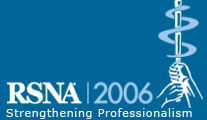
Abstract Archives of the RSNA, 2006
SSG23-05
Clinical Validation of CT-based Attenuation Correction of Tc-99m Sestamibi Myocardial Perfusion Imaging Using Multi-slice SPECT-CT
Scientific Papers
Presented on November 28, 2006
Presented as part of SSG23: Nuclear Medicine (Cardiovascular)
James Robert Corbett MD, Presenter: Nothing to Disclose
James N. Kritzman BS, Abstract Co-Author: Nothing to Disclose
Tahir Mohmed MD, Abstract Co-Author: Nothing to Disclose
Edward Ficaro PhD, Abstract Co-Author: Nothing to Disclose
The purpose of this study was to evaluate the diagnostic accuracy of CT based AC using a recently available hybrid imaging system in patients of widely varying body habitus.
37 consecutive patients with recent coronary angiographic correlates and 58 low likelihood normals irrespective of body habitus (weight up to 173 Kg) were studied. Imaging was performed using Siemens SYMBIA-T6 SPECT-CT imaging systems (Siemens Medical Solutions, Hoffman Estates, IL). All patients were imaged using a stress Tc-99 sestamibi protocol and CT based AC. Breathhold CT acquisitions were acquired with 0.6 sec rotational speed, effective mAs 35 kV, pitch 1.0 at end tidal expiration or early inspiration, 5-7 sec. acquisition time. SPECT images were reconstructed for AC and scatter correction and standard filtered backprojection methods. Uncorrected (NC) images were compared to CT AC images using 4D-MSPECT. Perfusion defects were assessed by scoring the severity and extent of perfusion defects in each of the three coronary artery distributions (LAD, LCX, and RCA) using standard 17 segment model.
Normalcy was significantly improved, often with dramatic effect in morbidly obese individuals (uncorrected 64% versus AC 91%, p<0.001). Defects associated with angiographic disease were preserved or enhanced while attenuation artifacts were generally well corrected. The sensitivity of SPECT for angiographic stenoses (≥50% diameter stenosis) increased from 69% NC to 88% with CT AC (p<0.05). Specificity for non-stenosed territories increased from 45% to 69% (p<0.05), and accuracy for correctly classifying coronary territories overall increased from 60% to 79% (p<0.05).
CT based AC showed significant improvements in image quality and normalcy compared to conventional cardiac SPECT imaging. Accuracy for the identification of stenosed coronary territories with CT AC compared to uncorrected imaging likewise demonstrated significant improvements in diagnostic sensitivity, specificity and accuracy.
Breathhold spiral CT based attenuation correction provides significant improvements in diagnostic accuracy in patients of widely varying body habitus including many morbidly obese individuals.
Corbett, J,
Kritzman, J,
Mohmed, T,
Ficaro, E,
Clinical Validation of CT-based Attenuation Correction of Tc-99m Sestamibi Myocardial Perfusion Imaging Using Multi-slice SPECT-CT. Radiological Society of North America 2006 Scientific Assembly and Annual Meeting, November 26 - December 1, 2006 ,Chicago IL.
http://archive.rsna.org/2006/4442426.html

